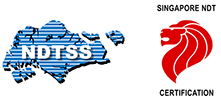What is Non-Destructive Society ?
Nondestructive testing (NDT) is the process of inspecting, testing, or evaluating materials, components or assemblies for discontinuities, or differences in characteristics without destroying the serviceability of the part or system. In other words, when the inspection or test is completed the part can still be used.
In contrast to NDT, other tests are destructive in nature and are therefore done on a limited number of samples (“lot sampling”), rather than on the materials, components or assemblies actually being put into service.
 These destructive tests are often used to determine the physical properties of materials such as impact resistance, ductility, yield and ultimate tensile strength, fracture toughness and fatigue strength, but discontinuities and differences in material characteristics are more effectively found by NDT.
These destructive tests are often used to determine the physical properties of materials such as impact resistance, ductility, yield and ultimate tensile strength, fracture toughness and fatigue strength, but discontinuities and differences in material characteristics are more effectively found by NDT.
Today modern nondestructive tests are used in manufacturing, fabrication and in-service inspections to ensure product integrity and reliability, to control manufacturing processes, lower production costs and to maintain a uniform quality level. During construction, NDT is used to ensure the quality of materials and joining processes during the fabrication and erection phases, and in-service NDT inspections are used to ensure that the products in use continue to have the integrity necessary to ensure their usefulness and the safety of the public.
It should be noted that while the medical field uses many of the same processes, the term “nondestructive testing” is generally not used to describe medical applications.
(source www.asnt.org)
How It can benefit you?
This NDT method is most widely used all over the world. This method uses X or Gamma radiation as probing energy and Film as a recording medium. Other techniques of this method uses Imaging Screen or suitable imaging system.
It is an internal examination method and most sensitive to volumetric defects (Porosity, Slag inclusions). In order to get maximum sensitivity the defect must be parallel to the radiation beam. As the angle between major axis of the planar defect and radiation beam increases the defect sensitivity decreases rapidly.
Radiographic testing is a time consuming process. The exposed films has be processed in order to decide the acceptability of the part being tested. The cost also relatively high compared to Ultrasonic or Magnetic or Penetrant testing methods.
Radiation safety also an important aspect that is always to be addressed according to local statutory.
Please follow the links if you need more information:
- 1. For basic science – NDT Resources
- 2. For detailed RT – NDT Resources – RT | Kodak – Radiography in Modern Industry
What background Knowledge is necessary?
Ultrasonic Testing also one of the most widely used NDT method. This method uses ultrasound as a probing energy and CRT or LCD as a display. The new equipments includes digital display, saving and print options.
This method is relatively fast. The equipment must be standardized with calibration blocks in order to understand and evaluate the indications. It is an internal examination method and highly sensitive to planar defects (Cracks, Lack of fusion) rather than volumetric defects such as porosity or slag inclusions
The contact testing and immersion testing are two main methods widely employed. The reliability of testing highly depends on the operator skills.
- For basic science – NDT Resources | Nondestructive Testing Encyclopedia -UT from ndt.net
- For detailed UT – NDT Resources – UT#
What kind of training we provide?
First In Asia
NDT PERSONNEL TRAINING AND CERTIFICATION SCHEME WHICH COMPLIES WITH BOTH ISO 9712 & EN 473 STANDARDS.
Singapore NDT Certification Scheme (SGNDT)
NDT certification scheme varies globally from countries to countries. A proper certification scheme is required to produce successful NDT practitioners to suit local industry requirements. Almost all of the developed countries in the world have their own schemes, for example countries like Australia, Japan, Germany and Canada just to name a few, have developed and operated their own national NDT certification scheme.
The NDT personnel certification schemes that are enjoying global recognition currently are:
- ACCP- Administered by The American Society of Non-Destructive Testing
- CSWIP- Administered by the Welding Institute
- PCN- Administered by The British Institute of Non-Destructive Testing
- ASNT Level-3 – Administered by The American Society of Non-Destructive Testing
All of the above mentioned schemes operate independently of any private organizations and are responsible for the maintenance and integrity of their nominated certifying schemes. These central certification schemes allow qualified technicians to carry out NDT on any site for any employer.

